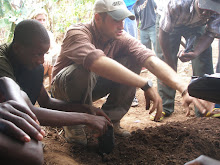I spent today at the LIDEFO working with my beekeeping counterparts Simon and Joukous on a lesson plan for our workshops. We had hours of questions and answers today, which was fun. Their questions were mostly on bee biology and communication, and most of the answers I gave left them with eyes of astonishment. I love that about bees, they never cease to amaze. When I told Simon that the queen can lay up to 2000 eggs a day, more than her own bodyweight. He looked like I slapped him as he exclaimed eh ehhhhh! Then his grimace turned into a smile that left him shaking his head. I suppose it was good practice for the upcoming workshops. two straight days of me talking even slower than I usually do will be exhausting, that's why I added energizers and group discussions.
The first workshop starts tomorrow at 9AM. we are traveling to Bwera near the Democratic Republic of Congo border to meet with the farmers who are already selling honey to LIDEFO and those who would like to start. Here is the agenda we came up with for our next two days in Bembe. I tried to keep it as close to the workbooks we got from Bees for Development as possiable. I will leave those when I go, and I want Simon and Jouckus to continue the trainings long after I go.
Agenda for Kasese
Beekeeping Workshops
Day 1
1.
Value and life of the honey bee 9:00AM
·
Benefits of keeping bees
·
What bees need
·
Life and Biology of honey bees
·
Plants for bees/ Conserving the environment
·
Energizer: Make a local flowering calendar with participants
2.
Break 10:45AM
3.
Choosing and making a bee hive 11:00AM
·
Types of hives
·
Fixed comb hives/traditional/local
·
Kenyan top-bar hive (KTB)
·
Langstroth/frame
·
Comparison of different types of hives
·
Energizer: During lunch collect local materials,
which can be used to make a hive.
4.
Lunch 12:30PM
5.
Colony Management 1:30PM
·
Energizer continued: participants demonstrate
how they would make hives from the collected local materials.
·
Keeping bees in hives (review covered material)
·
Continue calendar to include times of farming
activities and beekeeping activities
·
Setting up an apiary
·
Protective clothing and smokers
·
Safety
·
Observing and inspecting bees
·
Splitting the colony and catching a swarm
·
Pests and predators
6.
Visit hives if time allows 3:00PM
Day 2
7.
Visit Hives: identify queen, eggs, larva, pupa,
nectar, honey, pollen, queen cells, etc. 9:00AM
8.
Harvesting and processing honey 11:00AM
·
Harvesting from fixed comb hives
·
Harvesting from KTB hives
·
Harvesting from Frame/Langstroth
·
Separating honey by crushing and filtering
·
Separating honey using the pressing method
·
Storing, packing, and selling
·
Granulation/crystallization
9.
Lunch 12:30PM
10. Harvesting
and packaging beeswax 2:00PM
·
Value, uses, and quality
·
Rendering beeswax
·
Solar wax extractor
·
Storing and selling beeswax
11. Visit more hives as time allows and say
goodbye 3:00PM

1 comment:
Dan what was harveting from fixed comb hives about?
ralph
Post a Comment